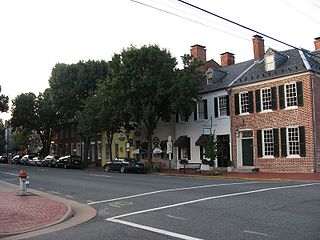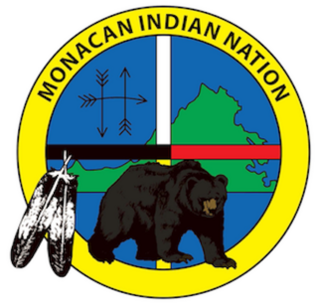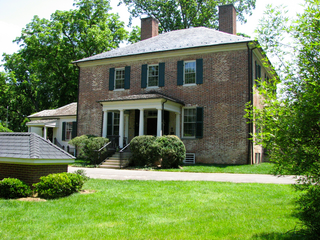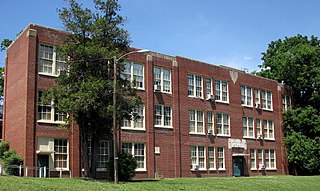Related Research Articles

Spotsylvania County is a county in the Commonwealth of Virginia. It is a suburb approximately 60 miles (90km) south of D.C. It is a part of the Northern Virginia region and the D.C. area. As of 2024, Spotsylvania County is the 14th most populated county in Virginia with 149,588 residences. Its county seat is Spotsylvania.

Orange County is a county located in the Central Piedmont region of the Commonwealth of Virginia. At the 2020 census, the population was 36,254. Its county seat is Orange. Orange County includes Montpelier, the 2,700-acre (1,100 ha) estate of James Madison, the 4th President of the United States and often known as the "Father of the Constitution". The county will celebrate its 290th anniversary in 2024.

Fredericksburg is an independent city in Virginia, United States. As of the 2020 census, the population was 27,982. It is 48 miles (77 km) south of Washington, D.C., and 53 miles (85 km) north of Richmond. The Bureau of Economic Analysis of the United States Department of Commerce combines the city of Fredericksburg with neighboring Spotsylvania County for statistical purposes.

Caroline County is a United States county located in the eastern part of the Commonwealth of Virginia. The northern boundary of the county borders on the Rappahannock River, notably at the historic town of Port Royal. The Caroline county seat is Bowling Green.

The Monacan Indian Nation is one of eleven Native American tribes recognized since the late 20th century by the U.S. Commonwealth of Virginia. In January 2018, the United States Congress passed an act to provide federal recognition as tribes to the Monacan and five other tribes in Virginia. They had earlier been so disrupted by land loss, warfare, intermarriage, and discrimination that the main society believed they no longer were "Indians". However, the Monacans reorganized and asserted their culture.

The Pamunkey Indian Tribe is one of 11 Virginia Indian tribal governments recognized by the Commonwealth of Virginia, and the state's first federally recognized tribe, receiving its status in January 2016. Six other Virginia tribal governments, the Chickahominy, the Eastern Chickahominy, the Upper Mattaponi, the Rappahannock, the Monacan, and the Nansemond, were similarly recognized through the passage of the Thomasina E. Jordan Indian Tribes of Virginia Federal Recognition Act of 2017 on January 12, 2018. The historical people were part of the Powhatan paramountcy, made up of Algonquian-speaking nations. The Powhatan paramount chiefdom was made up of over 30 nations, estimated to total about 10,000–15,000 people at the time the English arrived in 1607. The Pamunkey nation made up about one-tenth to one-fifteenth of the total, as they numbered about 1,000 persons in 1607.

The Manahoac, also recorded as Mahock, were a small group of Siouan-language Native Americans in northern Virginia at the time of European contact. They numbered approximately 1,000 and lived primarily along the Rappahannock River west of modern Fredericksburg and the Fall Line, and east of the Blue Ridge Mountains. They united with the Monacan, the Occaneechi, the Saponi and the Tutelo. They disappeared from the historical record after 1728.

Central Park is a shopping complex in Fredericksburg, Virginia, with 166 businesses. The complex is located near the intersection of Interstate 95 and State Route 3. Many national big-box stores, restaurants, and smaller local businesses occupy the Central Park complex. The complex has 2,200,000 square feet (200,000 m2) of leased retail space. The complex's developer, the Silver Companies, describes Central Park as "The East Coast's Largest Power Retail Center". In the 2004 rankings from the American Studies Department at Eastern Connecticut State University, Central Park was ranked as the largest unenclosed mall on the East Coast, and as the seventh largest mall in the United States.

The Native American tribes in Virginia are the Indigenous peoples whose tribal nations historically or currently are based in the Commonwealth of Virginia in the United States of America.

Fredericksburg station is a passenger rail station in Fredericksburg, Virginia. It is served by Amtrak's Carolinian, Northeast Regional, and Silver Meteor trains, and the Virginia Railway Express's Fredericksburg Line. The station has two side platforms serving the two elevated tracks of the RF&P Subdivision. It is located on Lafayette Boulevard at the south end of the downtown area.
The Free Lance–Star is the principal daily newspaper distributed throughout Fredericksburg, Virginia, United States, with a circulation area including the city of Fredericksburg and all or parts of the counties of Spotsylvania, Stafford, King George, Caroline, Culpeper, Fauquier, Louisa, Orange, Prince William and Westmoreland.
The Patawomeck are a Native American tribe based in Stafford County, Virginia, along the Potomac River. Patawomeck is another spelling of Potomac.

Richard Marc Edward Evonitz was an American serial killer, kidnapper, and rapist responsible for the deaths of at least three teenaged girls in Spotsylvania County, Virginia, and the abduction and rape of Kara Robinson in Richland County, South Carolina. Evonitz has been suspected of other murders, and confessed to other crimes to his sister shortly before committing suicide.

The Spotsylvania Towne Centre is a mall located in Spotsylvania County, Virginia, on Virginia State Route 3, less than a mile west of Interstate 95, and directly across from the Central Park shopping and dining complex. The mall is owned and developed by Cafaro Company. The property was renamed as "Spotsylvania Towne Centre" at the beginning of a $12 million renovation project. The project, completed in 2009, included an extensive remodeling of the mall's interior and exterior. At the same time, construction was begun on an outdoor lifestyle center called "The Village." The mall's anchor stores are Guitar Center, Dick's Sporting Goods, Belk, Costco, JCPenney, and Macy's. There is 1 vacant anchor that was once Sears. The Splitsville Bowling Alley is connected to a movie theater. The mall also houses over 150 specialty stores and restaurants.

Kenmore,, is a historic house in Spotsylvania County, Virginia, United States. It was built in 1829 by Samuel Alsop, Jr. (1776–1859) for his daughter Ann Eliza and her husband, John M. Anderson. The home bears the same name as the home of Fielding and Betty Lewis in nearby Fredericksburg, Virginia. To distinguish the houses, Kenmore in Spotsylvania County was renamed Kenmore Woods. Samuel Alsop, Jr. designed a number of homes in Spotsylvania County. In addition to Kenmore, he also designed and built "Oakley" for another daughter as well as his own home, "Fairview". In all, Alsop designed and built 10 homes.

Fall Hill is a plantation located near the falls on the Rappahannock River in Fredericksburg, Virginia. Though the Thornton family has lived at Fall Hill since the early 18th century, the present house was built in 1790 for Francis Thornton V (1760–1836). The land on which Fall Hill is located is part of an 8,000 acres (3,200 ha) land patent obtained by Francis Thornton I (1657–1727) around 1720. The present-day town of Fredericksburg, Virginia is located on that original patent.

Oakley is a historic plantation and home located in Spotsylvania County, Virginia, Virginia. The Federal/Georgian style, 2+1⁄2-story home was built in 1828 by Samuel Alsop, Jr. as a wedding present for his daughter, Clementina. Alsop built several notable houses in Spotsylvania County including Kenmore, Spotswood Inn, and Fairview.

The Matthew Fontaine Maury School, in Fredericksburg, Virginia, is an historic school building noted for its Colonial Revival architecture and design as well as its significance in the entertainment and cultural life of Fredericksburg. The architect of the building was Philip Stern. Built in 1919-1920, the school was used from then until 1952 for both elementary and high-school students. After the construction of James Monroe High School, the building was used as an elementary- and middle-school. The school was closed in 1980. Maury School was added to the National Register of Historic Places in March 2007.

Walker–Grant School is a historic school in Fredericksburg, Virginia. The school was built in 1938 and was the first publicly supported black high school in Fredericksburg. The school was named for Joseph Walker and Jason Grant (1861–1951) who worked to establish the school. The Art Deco designed school was added to the National Register of Historic Places in October 1998.

Spotsylvania is a commuter rail station on the Virginia Railway Express Fredericksburg Line, located off US Route 17 in Spotsylvania County, Virginia, about 5 miles (8.0 km) south of downtown Fredericksburg in the unincorporated community of Olive. It opened on November 16, 2015 – the first extension of VRE service since its opening.
References
- 1 2 3 4 5 "Matthew Fontaine Muary School" (PDF). National Register of Historic Places Registration Form. United States Department of the Interior; National Park Service. Retrieved June 9, 2012.
- 1 2 3 4 "Fredericksburg Dog Mart". Izaak Walton League of America: Fredericksburg-Rappahannock Chapter. Retrieved June 10, 2012.
- 1 2 Hedelt, Rob (July 23, 2009). "Dog Mart hopes to have its day, again". The Free Lance-Star; Fredericksburg, Virginia. Archived from the original on January 23, 2013. Retrieved June 10, 2012.
- 1 2 "Virginia Commission of Game and Inland Fisheries". Virginia Wildlife. 23 (6). 1962. Retrieved June 9, 2012.
- 1 2 3 Howard, Blair; Burnham, Mary K.; Burnham, Bill (2005). The Virginia Handbook. Hunter Publishing, Inc. p. 94. ISBN 9781588435125 . Retrieved June 10, 2012.
- 1 2 3 "History of The Dog Mart". The 2012 Fredericksburg Dog Mart. Fredericksburg-Rappahannock Chapter of the Izaak Walton League. Retrieved June 9, 2012.
- 1 2 Minnick, Don (September 25, 1997). "Dog Mart Has Rich Tradition". The Free Lance-Star; Fredericksburg, Virginia. Retrieved June 14, 2012.
- 1 2 Van Duyne, Marty (October 8, 2009). "Weekend goes to the dogs". Stafford County (Virginia) Sun. Archived from the original on February 3, 2013. Retrieved June 14, 2012.
- 1 2 3 4 Derr, Mark (2005). A Dog's History of America: How Our Best Friend Explored, Conquered, And Settled a Continent. Macmillan. pp. 55–58. ISBN 9780374529970.
- ↑ McCartney, Martha W. "Laws Regulating Interaction with the Native Population". A Study of Virginia Indians and Jamestown: The First Century. United States Department of the Interior; National Park Service. Archived from the original on November 2, 2012. Retrieved June 10, 2012.
- 1 2 Mansfield, James Roger (1977). An History of Early Spotsylvania. Orange, Virginia: Green Publishers, Inc. p. 3. ISBN 9780685898253.
- ↑ Federal Writers' Project (1952). Virginia: A Guide to the Old Dominion. US History Publishers. p. 217. ISBN 9781603540452.
- ↑ Moser, James (August 20, 1964). "Program is Rounded Out for Oct. 3 Dog Mart". The Free Lance-Star; Fredericksburg, Virginia. Retrieved June 14, 2012.
- ↑ Fitzgerald, Ruth Coder (September 25, 1999). "Dog Curb Market hits the big time". The Free Lance-Star; Fredericksburg, Virginia. Retrieved June 14, 2012.
- ↑ "Fix Dog Curb for Oct. 5". The Free Lance-Star; Fredericksburg, Virginia. September 14, 1929. Retrieved June 14, 2012.
- ↑ "Animals: Dog Mart". Time . Vol. 30, no. 17. October 25, 1937. Archived from the original on July 30, 2010. Retrieved June 10, 2012.
- ↑ "Dog Mart on Way Back to Old Virginia". Schenectady Gazette; Schenectady, New York. July 15, 1948. Retrieved June 10, 2012.
- ↑ Woolf, Gwen (October 6, 2001). "Tales from the Dog Mart". The Free Lance-Star; Fredericksburg, Virginia. Retrieved June 10, 2012.
- ↑ Goolrick, John (August 22, 1980). "Fredericksburg Dog Mart to go Dogless this year". The Free Lance-Star; Fredericksburg, Virginia. Retrieved June 10, 2012.
- ↑ Derr, Mark (2004). Dog's Best Friend: Annals of the Dog-Human Relationship. University of Chicago Press. p. 63. ISBN 9780226142807.
- ↑ Caprara, Collette (September 30, 2010). "The Delightful Downtown Fredericksburg Dog Fair is this Saturday". The Free Lance-Star; Fredericksburg, Virginia. Archived from the original on January 23, 2013. Retrieved June 9, 2012.
- ↑ "Life Guide". Life . Vol. 53, no. 14. Time Inc. October 5, 1962. p. 26. ISSN 0024-3019 . Retrieved June 9, 2012.
- ↑ Fitzgerald, Ruth Coder (September 26, 1998). "A doggone long tradition". The Free Lance-Star; Fredericksburg, Virginia. Retrieved June 14, 2012.